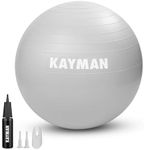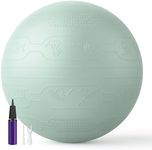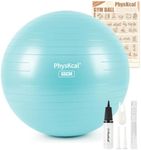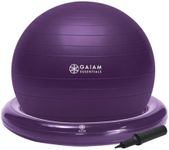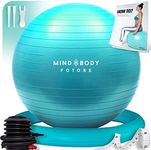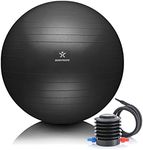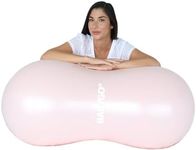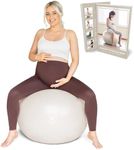Buying Guide for the Best Birthing Ball For Pregnancy
Choosing the right birthing ball for pregnancy can greatly enhance comfort and support during pregnancy, labor, and even postpartum recovery. A birthing ball, also known as a pregnancy ball or exercise ball, can help improve posture, reduce back pain, and prepare your body for labor. When selecting a birthing ball, it's important to consider several key specifications to ensure it meets your needs and provides the best support possible.SizeThe size of the birthing ball is crucial because it affects your comfort and the effectiveness of the exercises you can perform. Birthing balls typically come in different diameters, usually ranging from 55 cm to 75 cm. The right size for you depends on your height. Generally, if you are under 5'4'', a 55 cm ball is recommended; if you are between 5'4'' and 5'10'', a 65 cm ball is suitable; and if you are taller than 5'10'', a 75 cm ball is ideal. When sitting on the ball, your knees should be at a right angle, and your feet should be flat on the floor. This ensures proper posture and balance.
MaterialThe material of the birthing ball is important for durability and safety. Most birthing balls are made from PVC or similar materials that are anti-burst and non-slip. An anti-burst ball is designed to slowly deflate if punctured, rather than bursting suddenly, which is a crucial safety feature. A non-slip surface ensures that the ball remains stable during use, providing better grip and reducing the risk of slipping. When choosing a birthing ball, look for one that is labeled as anti-burst and has a textured surface for added safety.
Weight CapacityThe weight capacity of a birthing ball indicates how much weight it can safely support. This is important to ensure the ball can accommodate your weight comfortably and safely. Most birthing balls have a weight capacity of around 300 to 600 pounds. It's important to choose a ball with a weight capacity that exceeds your current weight to ensure it remains stable and safe during use. Consider any additional weight you might be carrying, such as during pregnancy, when selecting the appropriate weight capacity.
Inflation MethodThe inflation method refers to how the birthing ball is inflated and maintained. Some balls come with a hand pump or foot pump, while others may require a separate pump purchase. The ease of inflation is important for convenience, especially if you need to adjust the firmness of the ball over time. A ball that is easy to inflate and deflate allows you to customize the firmness to your preference, which can be beneficial for different exercises or stages of pregnancy. Consider how often you might need to adjust the inflation and choose a ball with a convenient inflation method.
VersatilityVersatility refers to the range of uses a birthing ball can offer beyond pregnancy. A versatile birthing ball can be used for various exercises, such as yoga, pilates, or general fitness, as well as for sitting and improving posture. This can make the ball a valuable tool not only during pregnancy but also postpartum and for general health and fitness. When selecting a birthing ball, consider how you plan to use it both during and after pregnancy, and choose one that can accommodate a variety of exercises and uses.




